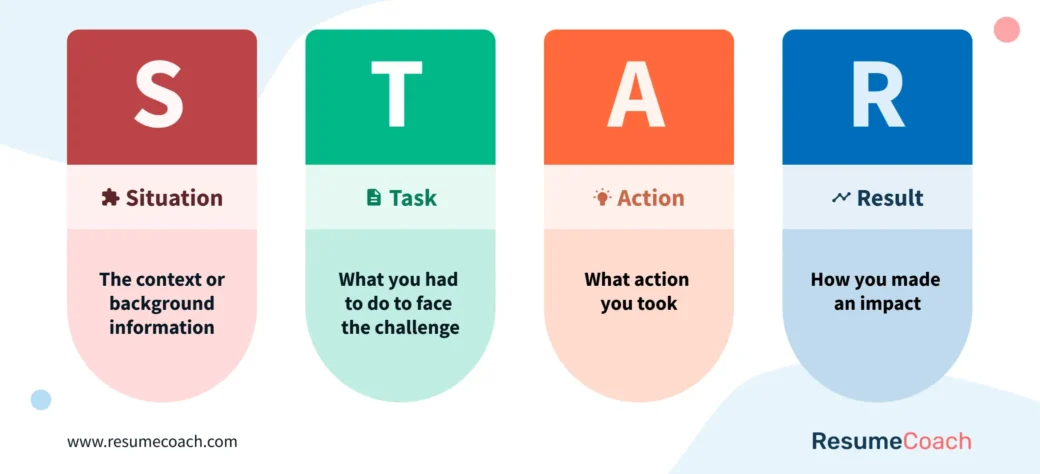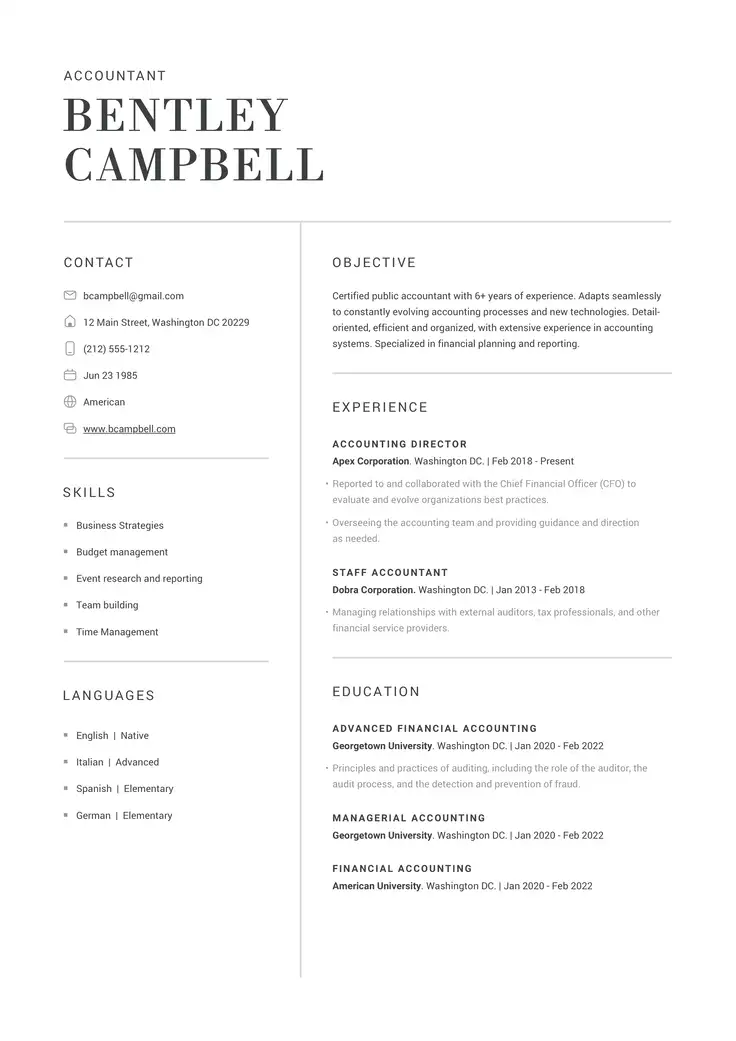In today’s competitive job market, hiring managers want more than a list of duties on your resume. They want specific examples that prove you can solve problems, take the initiative, and deliver measurable results.
That’s where the STAR method comes in.
STAR is a proven framework that can help you structure your resume content and answer behavioral interview questions. By framing your experience into concise, result-driven stories, you’ll be able to demonstrate to potential employers why you’re the most qualified candidate for the specific position.
In this guide, we’ll walk you through what the STAR method is, why you should use it, and common mistakes to avoid.
What Is the STAR Method?
STAR is a methodology for communicating your relevant skills, impactful achievements, and unique skills. It organizes your stories into four parts.
The four elements of the STAR method, and the following questions, can help you organize your professional achievements:
- S = Situation: What was the context or background?
- T = Task: What was my responsibility? What did I need to get done? What was my goal or challenge to overcome?
- A = Action: What did I do?
- R = Result: What was the outcome? How did my actions help or make a difference?

Here is what the STAR format looks like in action.
Achieved a 30% reduction in hospital readmissions and improved patient outcomes (R) after identifying high readmission rates among patients with multiple chronic conditions (S), addressing complex cases (T) through the implementation of targeted treatment plans (A).
This four-part STAR structure works because it forces you to be specific and shows results. Instead of vague statements like, “I managed a project,” you create an exact, results-focused story that proves your skills and ability to make an impact.
In the results section, whenever possible, include measurable results. For example, look for the amount of time or money saved, the number of customers served, or a percentage of increase.
💡Tip
Take advantage of ResumeCoach’s AI resume builder to help you highlight results and create a resume in minutes that follows the STAR method.
If you can’t measure or quantify the results, search for qualitative outcomes. This can include recognition from leadership or clients, process improvements, efficiency gains, stronger collaboration or team alignment, positive customer feedback, or improved user experience.
Similarly, if the results are neither positive nor measurable, what you learned can be a valid “Result.”
Why Use the STAR Method?
The STAR method can be used for both interviews and resumes. The framework will remain the same, but the execution can differ.
- The STAR method can transform vague resume bullet points into mini case studies or stories. These demonstrate how your actions lead to a measurable impact, not just duties.
- Using STAR responses or writing in this format demonstrates your ability to communicate effectively and concisely.
- If you’re feeling nervous about your interview, you may tend to ramble when answering questions. The STAR method helps you stay focused and provide clear, concise answers. It also demonstrates problem-solving skills and initiative.
- When you practice ahead of time with the STAR method, you’ll be able to approach answering behavioral interview questions with confidence and ease.
How To Use the STAR Method on a Resume
On your resume, you will not need to spell out “Situation,” “Task,” “Action,” and “Result,” nor do you need to take up four whole bullet points to tell your story. Instead, you should embed STAR logic within each bullet point.
What are good examples of the STAR method? Let’s outline the steps for adapting STAR for resume writing.
- Lead with an action verb like “Spearheaded,” “Optimized,” or “Implemented.”
- Set the scene briefly to give context. This can be drawn from your Situation or Task.
- Explain what you did (the Action).
- Show the measurable impact of the Result.
STAR method resume examples
Let’s look at how you might break down a social media marketing experience using the STAR method, which you can also adapt to your own role. Here’s the thought process:
Situation: Social media engagement dropped for three consecutive months.
Task: Improve engagement rates across all channels.
Action: Introduced a new content calendar, implemented A/B testing for ad campaigns, and collaborated with the design team to create colorful, interactive posts.
Result: Engagement on Instagram increased by 60%, and the campaign generated 1,200 new leads in one month.
Here is how you could present it on your resume in two succinct bullet points using action verbs and metrics. The different elements don’t need to be in the same order.
- Reversed (T) a 3-month decline in engagement (S) by launching a content calendar, A/B testing ads, and producing interactive visuals with design team (A).
- Drove a 60% increase in Instagram engagement and generated 1,200 new leads in one month (R).
Can you see how this narrative is more compelling than simply stating, “Successfully managed social media campaigns”? This also highlights your relevant experience and provides specific skills linked to the job posting.
If you wanted to include this as one strong, condensed bullet point, it could be written like this:
- Reversed 3-month decline in social media engagement by launching content calendar and A/B testing ads, boosting Instagram engagement by 60% and generating 1,200 leads.
More ways to use the STAR method on a resume
The STAR method is not limited to your work experience bullets; you can use it to describe your experiences in education, such as group projects.
With our AI summary generator, you can add the STAR framework straight into your opening statement as well. It can also feature when composing your resume summary. When you think in terms of the STAR framework, you’ll be sure to mention your strongest relevant skills and your impact.
💡Tip
If you’re still having trouble coming up with STAR job descriptions, you can use AI tools like ChatGPT to help with your application. For example, you can use a prompt like, “Help me organize this according to the STAR framework.”
How To Use the STAR Method in Job Interviews
STAR is beneficial when answering behavioral interview questions where employers want to know how you’ve handled challenging circumstances. These are the kinds of questions that start with phrases like “Tell me about a time when…” or “Give me an example of…”
The following three steps can help you prepare for a STAR method interview.
1 Analyze the job description before the interview
Highlight relevant skills and traits that the employer is seeking, such as leadership, adaptability, or problem-solving, or the responsibilities of the role.
2 Prepare three to five stories in advance
These specific examples should demonstrate that you have those abilities or experiences. Make sure they demonstrate a direct link to the most important skills in the job specification.
3 Practice your delivery
Now that you have prepared answers to common behavioral questions using STAR, you should ‘rehearse’ them to boost your confidence. Keep the Situation and Task descriptions short, and focus on the Action and Result.
STAR method interview response examples
Let’s look at STAR method answers to two common questions.
Interview Question: “Describe a challenge you overcame.”
My team’s client project was running two weeks behind schedule (S). As project manager, I needed to get us back on track without sacrificing quality (T). I reorganized the workflow, reassigned tasks based on strengths, and set daily check-ins (A). Finally, we delivered the project one day early, earning a 9.8/10 client satisfaction rating (R).
Sometimes, it can feel boastful to focus too much on your own accomplishments, especially when talking about promotions to leadership positions, but it’s essential for showcasing your abilities to the hiring managers.
Remember, they are asking you questions because they want to know that you can meet the expectations and demands of the role.
With that in mind, let’s see another example.
Interview Question: “Tell me about a time you led a team.”
Our company launched a new software tool for internal use, but adoption rates were low (S). I was promoted to team lead, and my goal was to increase usage across departments (T). So, I organized training workshops, created quick-start guides, and set up peer support groups (A). As a result of our team’s work, adoption rates increased from 45% to 92% within three months (R).
💡Tips
Avoid too much backstory, focus on your actions (not just what “the team” did), and if the result was not positive, emphasize what you learned instead.
You can also use ChatGPT to practice for your interview. Input the job posting, then ask Chat to generate potential interview questions or take on the role of the interviewer.
Type in your answers along with the prompt, “Provide feedback on this response, including whether it demonstrates evidence of the STAR framework.”
Common Mistakes to Avoid When Using the STAR Method
STAR is an easy method to master, but there are a few avoidable pitfalls some users fall into. Here are the most common, along with tips on how to sidestep them.
Too much backstory: Keep background details short. Don’t let them take up more than 20 percent of your answer.
No metrics in the result: Try to quantify wherever possible. “Increased sales by 20%” will always be more powerful than just “increased sales.”
Generic Actions: Avoid vague terms like “helped” or “worked on.” Replace these with strong verbs like “designed,” “developed,” or “negotiated.”
No clear takeaway: Always link back to the relevant skill or trait you want to highlight—the one the employer is seeking.
Here’s an example of how you can quickly fix problems like these:
Wrong ❌
Worked on a project that improved customer experience
Now see how this vague responsibility can be turned into an impressive achievement by adding more detail using STAR aspects.
Right ✅
Strengthened cross-team collaboration by introducing a weekly feedback session, earning recognition from leadership for improving communication and efficiency.
Finally, don’t forget to review your resume. Check for spelling and grammatical errors, but equally important is giving your statements a final STAR logic check. Do your bullets start with descriptive, impactful verbs? Have you included measurable results?
Final Tips & Takeaway
The STAR method is a proven way to showcase your skills in both resumes and job interviews. STAR logic helps you structure your experiences into concise, results-driven stories that provide hiring managers exactly what they are looking for: clear evidence that you can deliver.
What should you walk away with today?
Get into the habit of thinking in terms of your actions and how they have delivered quantifiable results, qualitative outcomes, or what you learned. Embed these in your resume bullet points.
Then, type them into our resume builder to get instant AI-powered suggestions.
After you’ve put these tips into practice, you can fit your STAR-optimized bullet points into a clean, professional resume template on ResumeCoach.
Mastering the STAR method is one of the best ways to create a great resume and succeed in job interviews. By structuring your work experience into clear, results-driven stories, you’ll show hiring managers exactly why they need you on their team!
What’s next? Review your resume today and rewrite at least three bullet points using STAR. Then, practice three STAR stories for your next interview. With this strategic approach, you’ll be ready to impress employers and land the role you’ve been working toward!
FAQs
The STAR method can be broken down into four parts.
S = Situation: The context or background to the story you want to tell.
T = Task: What you need to get done, or what challenge you had to overcome.
A = Action: What you did.
R = Result: What the outcome was. How the action made a difference.
To prepare for a STAR interview, review the job description carefully and identify the key skills the employer is looking for. You can think of specific examples from your past jobs that show how you’ve demonstrated those skills.
Then, remember to structure each answer using the STAR method. Then, before your interview, practice saying what you plan on saying during your interview aloud.
Some of the most common mistakes you can make during a STAR interview include giving answers that are too general or too long, skipping key parts of the framework, or not focusing enough on results.
Remember to choose clear, relevant stories, keep your answers structured and concise, and always highlight your personal contribution and the outcome with percentages or other quantifiable results.
Giving a STAR answer during an interview should last between 1 and 3 minutes. This gives you enough time to clearly explain the situation, task, action, and result.
This will help you avoid going off-topic, adding unnecessary background information, and making sure your answer remains relevant. Remember that your goal is to show off your skills and impact in a clear, structured way.
Related Posts


